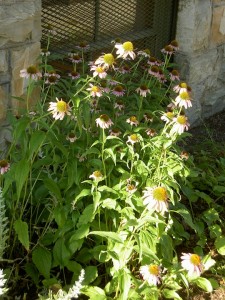By Diann Ericson
 “Pollinator” is a collective word referring to dozens of species that spread pollen. Many pollinators are common species, including bees, butterflies, moths, wasps, flies, ants, beetles, bats and hummingbirds. We see them, hear them and benefit from their work every day of our lives. Like them or not, they help put food on the table.
“Pollinator” is a collective word referring to dozens of species that spread pollen. Many pollinators are common species, including bees, butterflies, moths, wasps, flies, ants, beetles, bats and hummingbirds. We see them, hear them and benefit from their work every day of our lives. Like them or not, they help put food on the table.
Pollinators are primarily insect species. Bees (Hymenoptera) make up the vast majority of these insects and are the most important of the pollinating species in temperate North America. Unfortunately, the number of pollinators has declined drastically in recent years.
Pollination is the fertilization of plants without which the plant does not produce its seeds or fruits. Without it, there would be no fruit, nuts or vegetables. Pollinators are necessary for plant reproductive success and fitness. (Black, Sheppard et al. 2009) In addition the plants they pollinate provide food and shelter for many other animals.
 Examples of declining pollinators are numerous. Causes include increasing urbanization and expansion of intensive agriculture, invasive species, diseases, parasites and use of pesticides. “As pressure on pollinator species increases in developed and agricultural areas, the role of habitat in undeveloped areas that play as long-termed refugia for pollinator populations is substantial. Protecting, providing or enhancing new habitat is the best way to conserve native pollinators.” (Black, Sheppard et al. 2009)
Examples of declining pollinators are numerous. Causes include increasing urbanization and expansion of intensive agriculture, invasive species, diseases, parasites and use of pesticides. “As pressure on pollinator species increases in developed and agricultural areas, the role of habitat in undeveloped areas that play as long-termed refugia for pollinator populations is substantial. Protecting, providing or enhancing new habitat is the best way to conserve native pollinators.” (Black, Sheppard et al. 2009)
This was the motivation behind the Native Plant Program’s pollinator interpretive project of the Northern Region of the US Forest Service (USFS), initiated in 2008. The region offered funding to local forest districts via the Region’s twelve forests to create, publicize and maintain pollinator gardens. The money from this program was to be used for pollinator gardens on national forest lands. With assistance from Flathead National Forest’s conservation education specialist, Teresa Wenum, the After School Club (ASC) of Swan Ecosystem Center received funding and has produced enjoyable and positive environmental results by creating a native plant pollinator garden.
As one might expect, the garden project started from the ground up! The plant beds needed to be rejuvenated with fresh soil. This step took dozens of ASC hours and involved many volunteers including local residents and a Seeley Swan High School biology class. The old soil was replaced with a mixture of sand, compost and topsoil mixed in five- gallon buckets and wheel-barrowed into place.
 In the spring of 2010, as a component of the grant, an open house was held at the USFS Condon Work Center. The event included a native plant gardening workshop with Terry Divoky of Windflower Nursery in West Glacier and a presentation by students about their work on the project. Signs were added to the refurbished beds (planted in 2009). It was a great event! Now all that remains is maintaining the beds for the health of pollinators and the enjoyment of our residents and visitors.
In the spring of 2010, as a component of the grant, an open house was held at the USFS Condon Work Center. The event included a native plant gardening workshop with Terry Divoky of Windflower Nursery in West Glacier and a presentation by students about their work on the project. Signs were added to the refurbished beds (planted in 2009). It was a great event! Now all that remains is maintaining the beds for the health of pollinators and the enjoyment of our residents and visitors.
Besides the fact that a native plant program such as the one funded and discussed here improves our natural world, albeit in a small way, the connection between people, (particularly in our case, youth) and the natural world is of huge importance.
Although place-based education has been around since the 1970s there is a much greater awareness of it in the last decade. Now more clearly defined, place-based education incorporates academic achievement through service projects within the community. It provides opportunities to make tangible contributions to the resolution of local environmental issues and to conserve local environmental quality. Wetland restoration projects, native plant gardens, adopting species programs and water quality monitoring are core examples of placed-based education.
You can help further the efforts of such education by supporting your schools’ and community organizations’ efforts to increase outdoor education projects and programs, including those in your own backyard.
Sources:
Black, Sheppard, et al. Yolo Natural Heritage Program (HCP/NCCP) Pollinator Conservation Strategy. Xerces Society for Invertebrate Conservation.
Portland, Oregon. 2009.
Palladini, Jennifer. Interview. Division of Biological Science. University of Montana,
Missoula, Montana. 2011.
Wenum, Teresa. Flathead National Forest. Kalispell, Montana. 2011.
For more information:
Place-based education – www.promiseofplace.org
Montana Pollinator Partnership – http://www.pollinator.org/montana.cig.htm.
Fish & Wildlife Service’s pollinator site, with curricula http://www.fws.gov/pollinators/.
Montana Native Plants for Pollinator Friendly Plantings: http://www.mt.nrcs.usda.gov/technical/ecs/plants/pollinator/.
Tallamy, Doug, Bringing Nature Home, or the website http://bringingnaturehome.net


![Margaret Barr's "Strange Children" [ballet], 1955 / photographer unknown](https://flatheadcore.org/wp-content/uploads/2024/03/4944459226_e4c3f8fe5b_o-360x240.jpg)